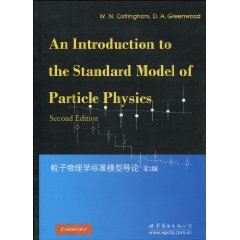圖書信息
書 名: 粒子物理學標準模

粒子物理學標準模型導論
型導論
作 者:考汀漢姆(W.N.Cottingham)
出版時間: 2010年4月1日
ISBN: 9787510005541
開本: 16開
定價: 49.00元
圖書目錄
Preface to the second edition
Preface to the first edition
Notation
1 The particle physicist's view of Nature
1.1 Introduction
1.2 The construction of the Standard Model
1.3 Leptons
1.4 Quarks and systems of quarks
1.5 Spectroscopy of systems of light quarks
1.6 More quarks
1.7 Quark colour
1.8 Electron scattering from nucleons
1.9 Particle accelerators
1.10 Units
2 Lorentz transformations
2.1 Rotations, boosts and proper Lorentz transformations
2.2 Scalars, contravariant and covariant four-vectors
2.3 Fields
2.4 The Levi-Civita tensor
2.5 Time reversal and space inversion
3 The Lagrangian formulation of mechanics
3.1 Hamilton's principle
3.2 Conservation of energy
3.3 Continuous systems
3.4 A Lorentz covariant field theory
3.5 The Klein-Gordon equation
3.6 The energy-momentum tensor
3.7 Complex scalar fields
4 Classicalelectromagnetism
4.1 Maxwell's equations
4.2 A Lagrangian density for electromagnetism
4.3 Gauge transformations
4.4 Solutions of Maxwell's equations
4.5 Space inversion
4.6 Chargeconjugation
4.7 Intrinsic angular momentum of the photon
4.8 The energy density of the electromagnetic field
4.9 Massive vector fields
5 The Dirac equation and the Dirac field
5.1 The Dirac equation
5.2 Lorentz transformations and Lorentz invariance
5.3 The parity transformation
5.4 Spinors
5.5 The matrices
5.6 Making the Lagrangian density real
6 Free space solutions of the Dirac equation
6.1 A Dirac particle at rest
6.2 The intrinsic spin of a Dirac particle
6.3 Plane waves and helicity
6.4 Negative energy solutions
6.5 The energy and momentum of the Dirac field
6.6 Dirac and Majorana fields
6.7 The E ] ] m limit, neutrinos
7.1 Probability density and probability current
7.2 The Dirac equation with an electromagnetic field
7.3 Gauge transformations and symmetry
7.4 Charge conjugation
7.5 The electrodynamics of a charged scalar field
7.6 Particles at low energies and the Dirac magnetic moment
8 Quantising fields: QED
8.1 Boson andfermionfield quantisation
8.2 Time dependence
8.3 Perturbation theory
8.4 Renornmalisation and renormalisable field theories
8.5 The magnetic moment of the electron
8.6 Quantisation in the Standard Model
9 The weak interaction: !ow energy phenomenology
9.1 Nuclear beta decay
9.2 Pion decay
9.3 Conservation of lepton number
9.4muondecay
9.5 The interactions of muon neutrinos with electrons
10 Symmetry breaking in model theories
10.1 Global symmetry breaking and Goldstone bosons
10.2 Local symmetry breaking and the Higgs boson
11 Massive gauge fields
11.1 SU(2) symmetry
11.2 The gauge fields
11.3 Breaking the SU(2) symmetry
11.4 Identification of the fields
12 The Weinberg——Salam electroweak theory for leptons
12.1 Lepton doublets and the Weinberg-Salam theory
12.2 Lepton coupling to the W
12.3 Lepton coupling to the Z
12.4 Conservation of lepton number and conservation of charge
12.5 CP symmetry
12.6 Mass terms in : an attempted generalisation
13 Experimental tests of the Weinberg——Salam theory
13.1 The search for the gauge bosons
13.2 The W bosons
13.3 The Z boson
13.4 The number of lepton families
13.5 The measurement of partial widths
13.6 Left-right production cross-section asymmetry and lepton decay symmetry of the Z boson
14 The electromagnetic and weak interactions of quarks
14.1 Construction of the Lagrangian density
14.2 Quark masses and the Kobayashi-Maskawa mixing matrix
14.3 The parameterisation of the KM matrix
14.4 CP symmetry and the KM matrix
14.5 The weak interaction in the low energy limit
15 The hadronic decays of the Z and W bosons
15.1 Hadronic decays of the Z
15.2 Asymmetry in quark production
15.3 Hadronic decays of the W
16 The theory of strong interactions: quantum chromodynamics
16.1 A local SU(3) gauge theory
16.2 Colour gauge transformations on baryons andmesons
16.3 Lattice QCD and asymptotic freedom
16.4 The quark-antiquark interaction at short distances
16.5 The conservation of quarks
16.6 Isospin symmetry
16.7 Chiral symmetry
17 Quantum chromodynamics: calculations
17.1 Lattice QCD and confinement
17.2 Lattice QCD and hadrons
17.3 Perturbative QCD and deep inelastic scattering
17.4 Perturbative QCD and e+e- collider physics
18 The Kobayashi-Maskawa matrix
18.1 Leptonic weak decays of hadrons
18.2 |Vud| and nuclear decay
18.3 More leptonic decays
18.4 CP symmetry violation in neutral kaon decays
18.5 B meson decays and B,B mixing
18.6 The CPTtheorem
……
